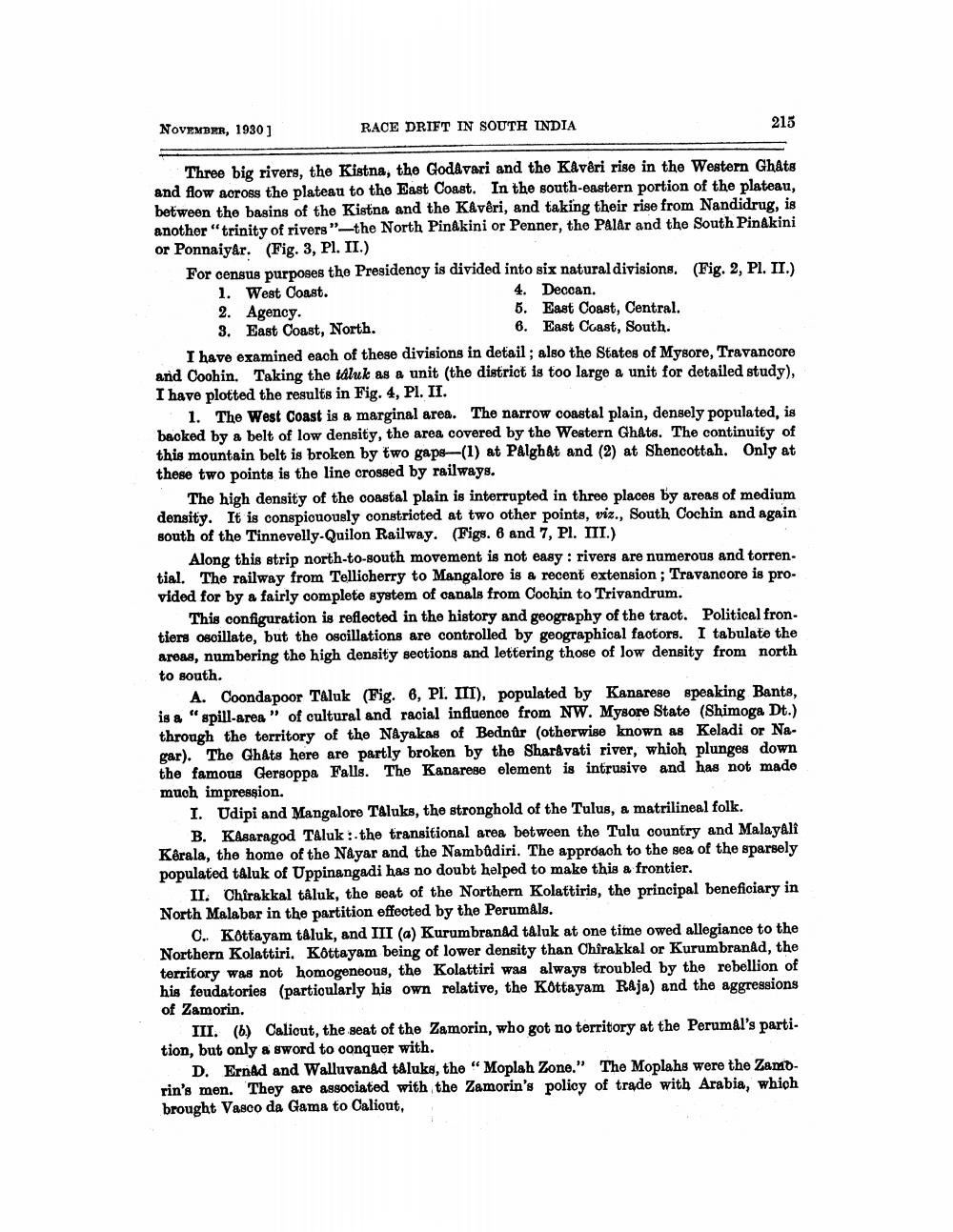________________
NOVEMBER, 1930 ]
RACE DRIFT IN SOUTH INDIA
215
Three big rivers, the Kistna, the Godavari and the Kaveri rise in the Western Ghats and flow across the plateau to the East Coast. In the south-eastern portion of the plateau, between the basing of the Kistna and the Kåvêri, and taking their rise from Nandidrug, is another "trinity of rivers"-the North Pinakini or Penner, the Palar and the South PinAkini or Ponnaiyår. (Fig. 3, P. II.) For census purposes the Presidency is divided into six natural divisions. (Fig. 2, PI. II.) 1. West Coast.
4. Deccan. 2. Agency
5. East Coast, Central. 3. East Coast, North.
6. East Coast, South. I have examined each of these divisions in detail; also the States of Mysore, Travancore and Coohin. Taking the taluk as a unit (the district is too large a unit for detailed study), I have plotted the results in Fig. 4, Pl. II.
1. The West Coast is a marginal area. The narrow coastal plain, densely populated, is backed by a belt of low density, the area covered by the Western Ghats. The continuity of this mountain belt is broken by two gape-(1) at Palghat and (2) at Shencottah. Only at these two points is the line crossed by railways.
The high density of the coastal plain is interrupted in three places by areas of medium density. It is conspicuously constricted at two other points, viz., South Cochin and again south of the Tinnevelly-Quilon Railway. (Figs. 6 and 7, PI. III.)
Along this strip north-to-south movement is not easy : rivers are numerous and torren tial. The railway from Tellicherry to Mangalore is a recent extension ; Travancore is provided for by a fairly complete system of canals from Cochin to Trivandrum.
This configuration is reflected in the history and geography of the tract. Political frontiers Oscillate, but the oscillations are controlled by geographical factors. I tabulate the areas, numbering the high density sections and lettering those of low density from north to south.
A. Coondapoor Taluk (Fig. 6, PI. III), populated by Kanarese speaking Bante, is a "gpill-area" of cultural and racial influence from NW. Mysore State (Shimoga Dt.) through the territory of the Nayakas of Bednar (otherwise known as Keladi or Nagar). The Ghats here are partly broken by the Sharavati river, which plunges down the famous Gergoppa Falls. The Kanarese element is intrusive and has not made much impression.
I. Udipi and Mangalore Taluks, the stronghold of the Tulus, a matrilineal folk.
B. Kasaragod Taluk : the transitional area between the Tulu country and Malayali Kórala, the home of the Nayar and the Nambâdiri. The approach to the sea of the sparsely populated taluk of Uppinangadi has no doubt helped to make this a frontier,
II. Chirakkal tâluk, the seat of the Northern Kolattiris, the principal beneficiary in North Malabar in the partition effected by the Perumals.
C. Kottayam tAluk, and III (a) Kurumbranad taluk at one time owed allegiance to the Northern Kolattiri. Kottayam being of lower density than Chirakkal or Kurumbranad, the territory was not homogeneous, the Kolattiri was always troubled by the rebellion of his feudatories (particularly his own relative, the Kottayam Raja) and the aggressions of Zamorin.
III. (6) Calicut, the seat of the Zamorin, who got no territory at the Perumal's parti. tion, but only & sword to conquer with.
D. Ernad and Walluvanad taluks, the “Moplah Zone." The Moplahs were the Zamorin's men. They are associated with the Zamorin's policy of trade with Arabia, which brought Vasco da Gama to Caliout,




